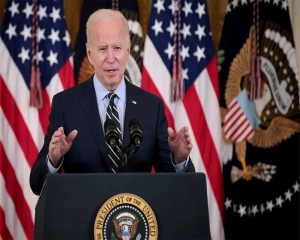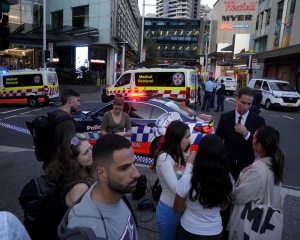In its 11th edition, TEDxGateway has hosted exceptional speakers who are slowly but surely changing the healthcare sector. SHALINI SAKSENA catches up with researchers who talk about how they have carved a niche for themselves
Creating a buzz at age 13
Rishab Jain (15)
Scientist and Inventor
He is a freshman in school at Portland, Oregon, US. He does a lot of science related activities and research on pancreatic cancer in the medical field and the application of applying artificial intelligence (AI) to medical treatment of pancreatic cancer. When he is not doing research, he is busy participating in science bowl — a buzzer-based competition for those who want to increase their knowledge, especially in Biology. A big part of his free time is spent in track and field running cross-country. Meet 15-year-old Rishab Jain, a scientist and an innovator who has invented the Pancreatic Cancer Deep Learning System (PCDLS), an AI tool that improves radiation treatment in cancer. He aspires to become a surgeon and hopes to cure pancreatic cancer one day.
He tells you that despite his busy school schedule and the time spent on research for pancreatic cancer, he does manage to find time for himself to pursue what he loves — running. “I was 13 when I found out about this cancer, after passing of a family friend from pancreatic cancer. I was intrigued and found out the survival rate and got to know that this cancer is extremely deadly and survival rate is very low. This is because it takes time to pinpoint the area of the cancer,” Jain says.
His system of AI that uses deep learning is a technique that offers an abstract way of looking inside and identifying patterns in the data. But he used another technique withing deep learning — convolutional neural network. This network, he tells you has the ability to look at images and identify patterns inside. “What I did was the data that I had of MRI and CT scan of abdominal area. Within the thousands of different pictures of the abdomen, I had different images of the organs including pancreas. I used my tool to predict where the pancreas is positioned which is extremely hard to find for the untrained eye. My goal was to improve the accuracy for radio therapy by segmenting the pancreas which can sometimes take a long time for a radiologist to do,” Jain explains.
Another benefit of his deep learning system is its real-time application. Rather than pinpointing the pancreas from the images and then moving on for treatment, if there is a AI tool — PCDLS — can locate pancreas within a couple of seconds. “It is all about the execution of the programme running the command. When we take the CT and MRI images, it becomes fast to locate the pancreas,” Jain says. He tells you that his tool is about early detection of this type of cancer.
“At present, pancreatic cancer treatment involves generic cancer treatment. Radiation therapy is a treatment that uses high doses of targeted energy to kill cancer cells and shrink the tumours. The problem in treating pancreatic cancer lies in its late detection – last stage. At this point, all one can do is shrink the tumour and if the patient is lucky, they can successfully remove the tumour,” Jain says.
Not only this, Jain is also named as America’s Top Young Scientist for his path breaking innovation to improve radiotherapy. A competition he entered when he was 13. “After I came up with the solution using AI for pancreatic cancer that began after a lot of reading and doing a lot of research I realised that it was something that can be used in the future and have a big impact after I got some success, I entered a competition — 3M Young Scientists Challenge. The great thing about this that they pick out the top ideas from the US that are presented and provide support like mentorship. The primary reason to enter the competition was if I was selected it would allow me to better my tool and I could look for a bigger expansion. After I was selected, I spent that summer improving on the accuracy of the tool. I got more data, I fined tuned it. It was then that my idea became a reality,” Jain says.
When he speaks at platforms like TedxGateway, the reaction of the people is centered more on his age. “When people see a young person talking while it can be a source of big inspiration, people may doubt it at first. I believe no matter what the age, anybody can make a difference. It just needs one idea that a person has to be passionate about and have the goal to complete it. With the right mindset and opportunity, it is possible to achieve that goal,” Jain says.
According to him the best overall invention has been the Internet that provided the biggest platform for everything. Just the creation of connecting multiple computers has made so many things possible today.
“In the medical world, I would say the CT technology that has had ginormous impact. When it was invented by Sir Godfrey Hounsfield invented back in 1967, it opened a lot of doors and possibilities for all kinds of treatments not just cancer,” Jain says.
His future is set. He would like to continue to work on his research. His latest project today involves working on whether they can improve on the treatment of the cancer — to solve the gap that exits today.
CAD gets a brand new voice
Yuval Mor (54)
AI Technologist and Disruptor
What if someone were to tell you that your voice is enough to detect several diseases including coronary artery diseases (CAD)? Most people would not believe it or would term it as fake news. However, the truth is that Beyond Verbal is doing just this.
Yuval Mor, CEO of Beyond Verbal, tells you that what his company uses the tone of voice of the people in order to be able to identify different health conditions. “It comes under what we call vocal biomarket – the area of voice to detect various diseases,” Mor says.
The journey began with the analysis of emotions from the voice. “We all know that we can understand what people are feeling just by listening to them. As part of this analysis, our scientists did an experiment. He found that group of people he was evaluating had reading dyslexia. Because of this, their analysis of their emotions was incorrect. The scientist came up with an idea that maybe there is something in the voice of the people that gives their health condition. This led to our research in many different areas like mental health, heart conditions, lung and breathing conditions and many more,” Mor explains.
The good part is that order to get the voice, there is no need for any complicated device to record the voice. All one needs to do is record the voice on your smartphone. Yes, you read that right. One can record the voice on any regular mobile that allows voice recording and one is good to go. All one has to do is record your voice; there are not set words needed, nor does one have to speak in a particular tone or pitch. All one has to do is record the voice – like the tone one uses while talking to another person over the phone.
“After the call is recorded, one can send it is a central control analysis where experts use machine learning and AI in order to find specific indications in the voice that could indicate health conditions,” Mor explains.
“Since we are speaking over the mobile all the time, we can see a pattern when there are deviations. We use regular voice recorded over a regular mobile. The success rate when it comes to detection of coronary artery disease using a single voice analysis stands at 86-87 per cent level of accuracy. The idea is not to scare people to rush to the hospital, it is a tool to let them know that there is something wrong and that needs to be addressed in the near future. And to also increase the person’s awareness level when the information is sent to their doctor who can then decide to go for further testing; the tool is not for emergency care; it is a monitoring device,” Mor tells you.
The advantage, he tells you are amazing. Just imagine, we are using the voice all the time and mobiles. This way one’s mobile or smart home device can be a personal bodyguard when it comes to health. The device that has been collecting voice recording over time gives information if there is signification deviation in the voice. All this is becoming part of tele-medicine or remote healthcare. The idea is that one doesn’t really have to go physically to a hospital but a lot interaction can happen remotely using sensory, in this case voice sensory,
Mor tells you that the future will be about using all kind of devices that people will have in their homes or at their disposal. Some of these will be connected to the smartphones like we are already seeing in terms of wearables that are available in the market today to check our BO and even heart rate. “Some devices would be more dedicated and connect to a software that would e running of the mobile to collect the vitals but using the voice to say monitor oxygen saturations. It is no longer the future, the future is here, we are living it and using it when we buy a smart watch,” Mor says.
Back to Nature innovations by a reluctant Master of science
Oded Shoseyov (63)
Nano biotechnologist
He was born to a family in the vineyard business for more than 130 years. Twenty years back, he established the Estate Boutique winery near Jerusalem in one of the oldest grape growing regions in the world from the time of King Solomon. In High School, he was a terrible student. Nevertheless, his parents always told him that he had potential and so he never gave up.
“After three-and-a-half years of service in the Israel Defence Force, I decided that I would like to go to university and study Agriculture so that I could go back to the vineyard and help my father. I had to struggle a lot to get accepted to the university because I had very low grades from High School. My application to the Faculty of Agriculture of Hebrew University was rejected. Thanks to the intuition of the Dean of Chemistry Professor Lena Ben-Dor, I was accepted on condition to do an undergraduate course in Chemistry at The Hebrew University where I really shined. I met Professor Ben Ami Bravdo who invited me to join his laboratory. The day I entered his lab, I knew that this is my destiny,” Oded Shoseyov tells you.
His research in plant molecular biology, protein engineering and nano biotechnology is creating super-performing materials that could change the way we build our future products.
Over the years, Oded has established 14 companies and asking him to talk about a particular one doesn’t come easy. “You are asking me to pick my favourite child. But I will do my best. CollPlant is a company that produces human collagen from tobacco plants. Collagen is a special protein that builds up tissues and organs in our body. Medical implants like bone substitutes and heart valve leaflets are made of collagen extracted from pigs, cows and human cadavers which are not safe because they harbour viruses. At the Hebrew University, my laboratory cloned all the five genes from humans that are responsible for making collagen in our body, and by genetic engineering introduced all the five human genes into a tobacco plant,” Oded explains.
He says that tobacco plants produce human collagen through their leaves. “We grow the tobacco plants in greenhouses, harvest the leaves, extract and purify the human collagen. This collagen is safer because plants do not harbour human pathogens. From this, we make different medical implants for wound healing and tendon repair that are already used in clinics in Europe and Israel.
“Our latest achievement and source of pride is the new version of collagen that can be 3D-printed. We are now engaged with United Therapeutics, a US Pharma company and 3D Systems, a US 3D printing company in an ambitious project to print for the first time a fully functional living human lung. This is only the first in printing of future organs,” Oded tells you.
Another company is Biobetter Ltd whose mission is to make biologic drugs affordable. He tells you that antibodies are large and complex proteins which are central in our immune system.
“They help our body to overcome infection and cancer. In the last decade, biologic drugs and specifically humanised antibodies became extremely effective drugs for Rheumatoid Arthritis, cancer and more. One major problem remain. Biologic drugs are produced by mammalian cell culture which is very expensive.
“We cloned the genes of Adalimumab (drug for rheumatoid Arthritis) and by genetic engineering introduced it into tobacco plant. We introduced several more genes into the plant to modify the sugar content of the Adalimumab to make it more human. We can produce the biologic drug in a greenhouse at a cost of lettuce. Our goal is to make it affordable — bring down the cost to less than $1 a day as opposed to $100 a day at present,” he adds.
His breakthrough was finding genes that are at the heart of a mechanism in plants that accelerates its growth. This discovery was later translated to transgenic eucalyptus trees that grow faster in the forest and enable production of timber and pulp for paper in a significantly shorter period of time.
According to him, over billions of years of evolution, Nature made amazing materials and systems. “I will mention only a few: Resilin which enables cat flees to jump 100-200 times their height and the amazing computational powers of our brain. Overabundance of these super performers around us are encoded by their DNA,” says Oded who is in India as a TEDxGateway speaker.
When he is not busy in his laboratory, he and his children are busy skiing and looking for new resorts to explore all over the world. He also enjoys mountain biking, running and music.


























